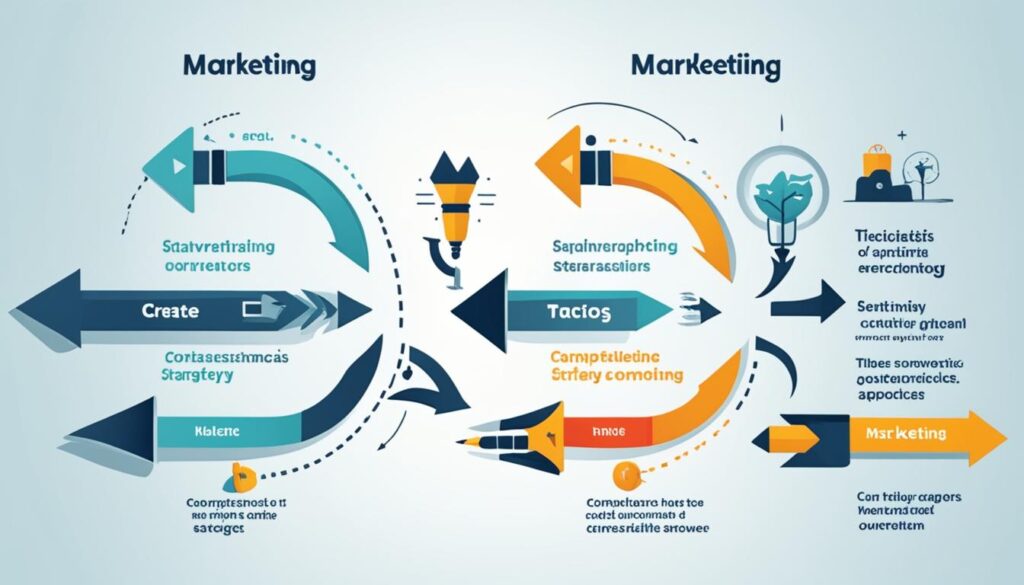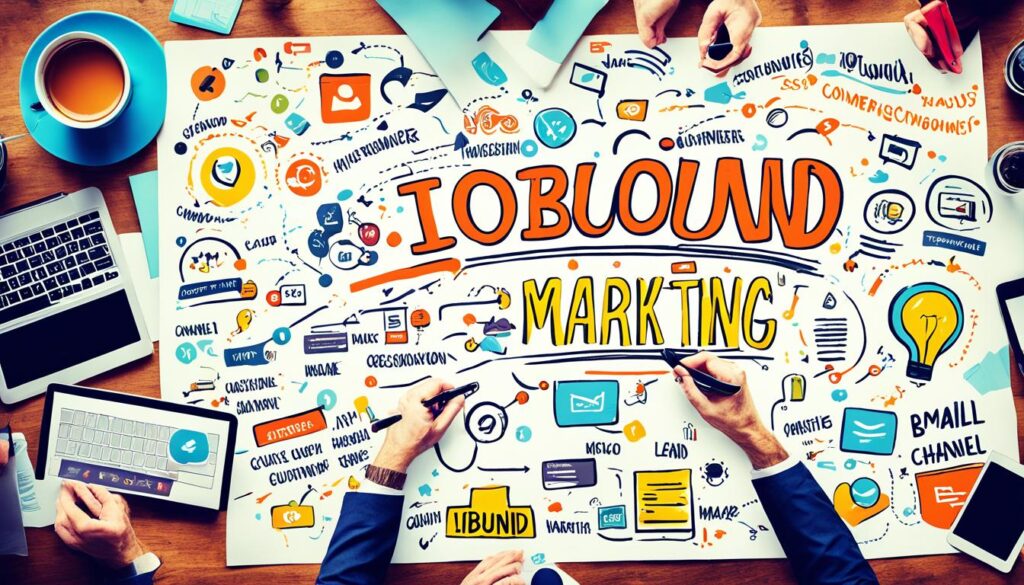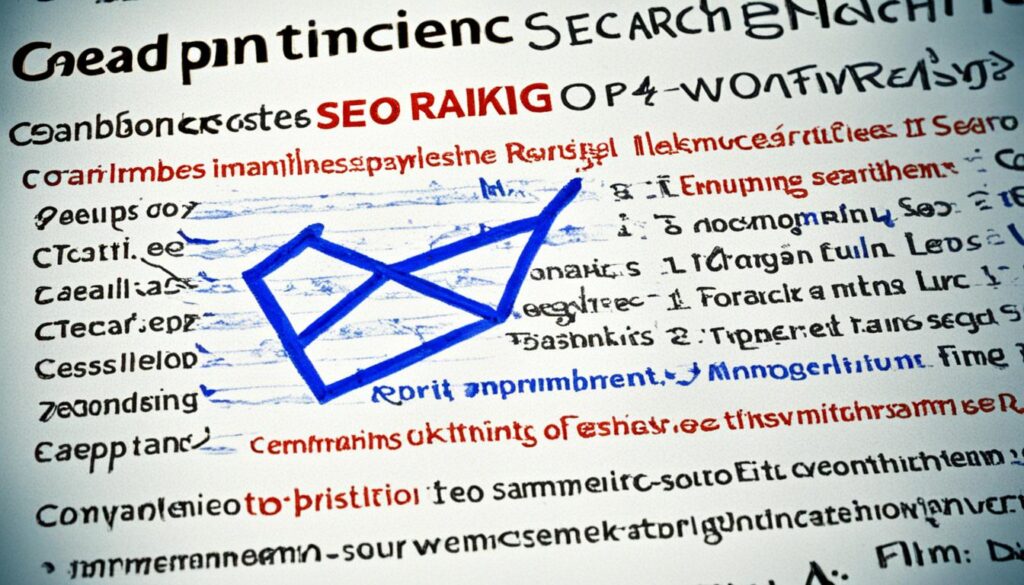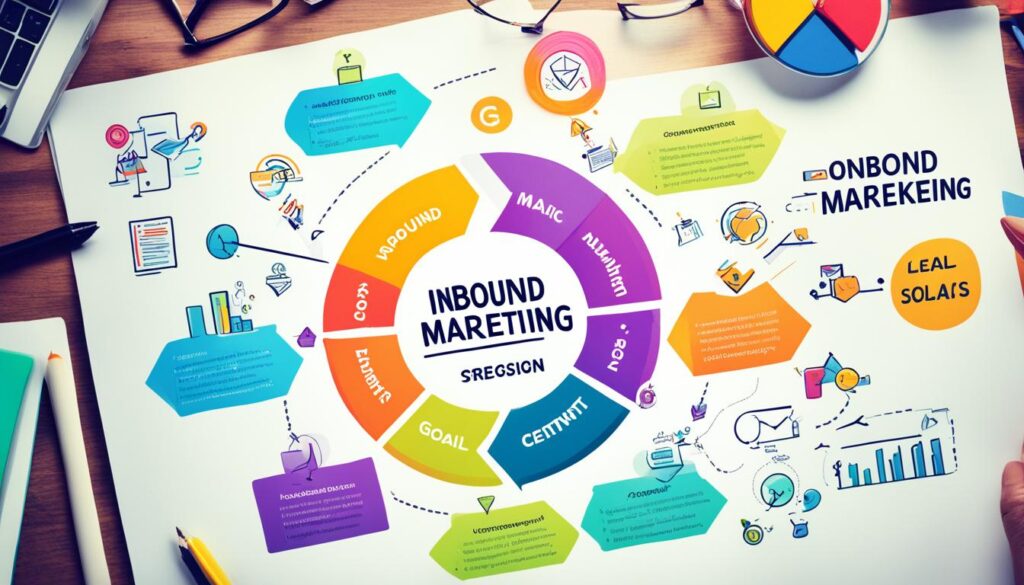Did you know that businesses that utilize effective inbound marketing methods see a 55% increase in lead generation compared to those using traditional outbound tactics? In today’s digital age, having a strong marketing strategy is crucial. This comprehensive guide explores inbound marketing strategies, offering practical advice and proven techniques to boost your online presence and build meaningful connections with your customers. Whether you’re a small business owner or a marketing professional, this ultimate guide will provide you with the knowledge and skills necessary to succeed in inbound marketing.
Key Takeaways:
- Implementing successful inbound marketing strategies can result in a 55% increase in lead generation.
- This guide will provide actionable tips and best practices to enhance your digital presence.
- Inbound marketing is crucial for both small businesses and marketing professionals.
- By the end of this guide, you will have the knowledge and techniques needed to succeed in inbound marketing.
- Unlock the potential of inbound marketing and drive growth for your business.
What is a Marketing Strategy?
A marketing strategy is a focused and achievable plan that helps us reach specific marketing-related goals. It takes into account our current strengths, weaknesses, and objectives, allowing us to develop tactics that align with our long-term goals.
It is important to differentiate between a marketing strategy and marketing tactics.
While a strategy provides a high-level plan to guide our direction, tactics are specific actions and methods used to implement the strategy and achieve short-term objectives. This distinction is crucial in effectively executing our marketing plan.
What is a Digital Marketing Strategy?
A digital marketing strategy is a comprehensive plan that focuses on utilizing online channels to establish a strong internet presence and achieve specific marketing objectives. By leveraging various web-based mediums, businesses can boost their visibility and attract new customers. Some of the key components of a well-planned digital marketing strategy include:
- Organic search: Optimizing website content and structure to improve search engine rankings and increase organic traffic.
- Social media: Utilizing platforms like Facebook, Twitter, and Instagram to engage with the target audience and drive brand awareness.
- Paid ads: Running targeted advertisements on platforms like Google AdWords and Facebook Ads to reach a wider audience and drive conversions.
- Other online channels: Exploring additional web-based mediums such as email marketing, influencer collaborations, and content partnerships to expand reach and attract new customers.
With a well-crafted digital marketing strategy, businesses can effectively achieve their marketing objectives and establish a strong online presence. By carefully selecting the appropriate online channels and utilizing them strategically, businesses can optimize their internet presence and maximize their success in the digital landscape.
Why is a Digital Marketing Strategy Essential?
In today’s digital age, having a strong internet presence is crucial for businesses of all sizes. A digital marketing strategy provides a roadmap for businesses to effectively navigate the online landscape and achieve their marketing objectives. By utilizing online channels efficiently, businesses can:
“A digital marketing strategy establishes a clear direction for businesses in the online world, helping them reach their target audience, generate leads, and drive conversions.”
A digital marketing strategy enables businesses to reach their target audience effectively, attract potential customers, and build brand awareness. It also helps drive website traffic, generate leads, and increase customer engagement. By aligning their marketing efforts with a well-defined digital strategy, businesses can optimize their online presence, improve their competitive edge, and achieve long-term success.
Strategy vs. Tactics in Marketing
Understanding the difference between a strategy and tactics is crucial in effective marketing. A strategy is a high-level plan that guides our marketing goals and outlines how we plan to achieve them. It serves as the overarching roadmap for our marketing efforts, providing a clear direction and focus.
On the other hand, tactics are the specific actions and methods we employ to implement our strategy and achieve short-term objectives. These tactics are the hands-on, day-to-day activities that drive the execution of our marketing plan. They are the practical steps we take to bring our strategy to life and make progress towards our goals.
Just like a general leading an army, our marketing strategy sets the overall course of action, while the tactics are the maneuvers and actions taken on the battlefield to win the war.
Both strategy and tactics are integral to a successful marketing plan. Without a well-defined strategy, our tactics may lack direction and coherence. On the other hand, without effective tactics, even the best strategy may remain merely theoretical and fail to achieve the desired results.
By striking the right balance between strategy and tactics, we can align our marketing efforts with our broader goals and create a cohesive, results-driven approach. Our strategy provides the foundation and vision, while our tactics serve as the executional elements that bring that vision to life.
The Role of Strategy:
Our marketing strategy acts as the guiding force behind our entire marketing plan. It helps us answer important questions, such as:
- What are our long-term marketing goals?
- Who are our target customers?
- What sets us apart from our competition?
- How do we plan on reaching our target audience?
Our strategy provides the framework for answering these questions and sets the direction for our tactical decisions. It enables us to make informed choices about which tactics will be most effective in achieving our desired outcomes.
The Role of Tactics:
While our strategy defines the “what” and “why” of our marketing plan, our tactics focus on the “how.” They are the specific actions and methods we use to implement our strategy and achieve our goals. Some examples of marketing tactics include:
- Developing targeted advertising campaigns
- Creating engaging content for our website and social media platforms
- Utilizing email marketing to nurture leads
- Optimizing our website for search engines
- Creating partnerships with influencers or industry leaders
These tactics are the practical steps we take to execute our strategy and drive the desired outcomes. While tactics may change and evolve over time, our strategy provides a stable foundation that keeps us focused on our marketing objectives.

By understanding the distinction between strategy and tactics, we can develop a comprehensive marketing plan that aligns with our goals. A well-crafted strategy sets the course, while effective tactics help us navigate the ever-changing marketing landscape and achieve tangible results.
The Four Stages of an Inbound Marketing Strategy
Inbound marketing is a highly effective strategy that guides customers through the four stages of the marketing funnel: attract, convert, close, and delight. Understanding these stages and implementing the right strategies at each step is crucial for driving success in your inbound marketing efforts.
1. Attract
The first stage of the inbound marketing strategy is to attract potential customers. This involves creating targeted content that resonates with your target audience. By optimizing your content for search engines and leveraging social media platforms, you can reach a wider audience and grab their attention.

For example, you can create blog posts or videos that address common pain points or provide valuable information related to your products or services. By offering useful and relevant content, you can draw potential customers to your website or social media profiles, increasing your chances of converting them into leads.
2. Convert
Once you’ve attracted visitors to your website or social media platforms, the next stage is to convert them into leads. This involves capturing their contact information and turning them into potential customers.
One effective way to do this is by utilizing landing pages, opt-in forms, and call-to-action buttons. By offering valuable resources or exclusive deals in exchange for their contact details, you can entice visitors to take the next step and provide their information.
“Effective conversion tactics are essential for lead generation.”
3. Close
After converting visitors into leads, the close stage focuses on nurturing those leads and turning them into paying customers. This is where email campaigns, CRM systems, and sales-focused content come into play.
By sending personalized and targeted emails, you can engage with your leads and provide them with valuable information that guides them through the buying process. Using a CRM system allows you to track and manage interactions with your leads, ensuring that you provide a seamless experience.
“The close stage is all about building trust and establishing a strong relationship with your potential customers.”
4. Delight
Delighting customers is a critical stage of the inbound marketing strategy. Providing exceptional customer service, personalized interactions, and valuable content can help you create loyal customers who will become advocates for your brand.
“Delighting customers leads to long-term relationships and increased customer loyalty.”
By continuously delighting your customers, you can encourage them to make repeat purchases, refer your business to others, and become promoters of your brand. This stage is essential for fostering customer loyalty and driving long-term success.
In conclusion, the four stages of the inbound marketing strategy – attract, convert, close, and delight – provide a comprehensive framework for guiding customers through the marketing funnel and building meaningful relationships. By implementing targeted strategies at each stage, you can enhance your inbound marketing efforts and drive growth for your business.
Benefits of Inbound Marketing
Inbound marketing offers numerous benefits for businesses. By adopting effective inbound marketing strategies, organizations can unlock the potential to enhance their brand awareness, engage customers on a deeper level, generate valuable leads, and drive website traffic. Let’s explore these benefits in detail:
Increased Brand Awareness
A key advantage of inbound marketing is its ability to expand brand awareness. By creating valuable and relevant content that resonates with your target audience, you can establish your brand as a trusted authority in your industry. Through consistent and strategic content distribution across multiple channels, you can reach a wider audience, increase online visibility, and boost brand recognition.
Enhanced Customer Engagement
Inbound marketing fosters meaningful customer engagement by focusing on delivering personalized experiences. By creating tailored content and utilizing interactive elements such as quizzes, surveys, or contests, you can capture the attention and interest of your audience. Through active participation and dialogue, you can cultivate stronger relationships with your customers, fostering loyalty and advocacy.
Effective Lead Generation
One of the primary goals of inbound marketing is to generate high-quality leads. By attracting prospects through valuable content, optimizing landing pages, and implementing compelling call-to-action elements, you can capture valuable information from potential customers. With this information, you can nurture and convert leads into loyal customers through targeted email campaigns and personalized experiences.
Increased Website Traffic
Inbound marketing strategies drive targeted traffic to your website by optimizing your content for search engines, utilizing social media channels, and incorporating effective promotional campaigns. By attracting visitors who are actively searching for information or solutions related to your industry, you can increase the visibility and relevance of your website in search engine results pages, resulting in a steady flow of organic traffic.
Overall, inbound marketing empowers businesses to build a strong online presence, establish trust and credibility, and cultivate long-term customer relationships. By strategically implementing inbound marketing techniques, you can maximize the benefits of brand awareness, customer engagement, lead generation, and website traffic, ultimately driving growth and success for your organization.

Inbound Marketing Examples
Real-life examples serve as powerful demonstrations of the success that can be achieved through inbound marketing strategies. Let’s take a look at one such example that showcases the effectiveness of this approach:
| Success Story | Brand | Result |
|---|---|---|
| General Electric’s Instagram Campaign | General Electric | Generated millions of views and reached a vast audience without spending money on ad spaces |
In this case, General Electric leveraged the power of inbound marketing through an engaging Instagram campaign. By creating visually appealing and informative content, they were able to capture the attention of millions of users and effectively increase brand visibility without relying on traditional advertising methods. This success story highlights the potential of inbound marketing to reach a wider audience and engage customers in a meaningful way.
It’s important to note that inbound marketing strategies can be tailored to fit the specific needs and goals of each business. The example above is just one illustration of the many possibilities that exist across various industries. By crafting compelling content and leveraging the right platforms, businesses can achieve similar success in terms of brand visibility and customer engagement.
Social Media Marketing in Inbound Marketing
Social media marketing plays a crucial role in a successful inbound marketing strategy. With platforms like Facebook, Twitter, Instagram, LinkedIn, and YouTube, businesses can increase brand awareness, engage with their audience, and drive valuable traffic to their websites.
To leverage the power of social media marketing effectively, it is essential to create engaging and relevant content that resonates with your target audience. This content can take various forms, such as informative blog posts, captivating images, entertaining videos, or thought-provoking podcasts. By providing valuable and shareable content, you can attract attention and establish your brand as a trusted source of information and entertainment.
Each social media platform has its unique characteristics and user demographics. It is crucial to optimize your posts and messages to suit the specific features of each platform. For example, shorter and punchier posts tend to perform better on Twitter, while captivating visuals and compelling captions are essential on Instagram. By tailoring your content to suit each platform, you can maximize your reach and engagement.
To improve audience engagement on social media, it is essential to interact with your followers. Respond to comments, address questions, and encourage conversations. Social media platforms provide an excellent opportunity to build relationships with your audience, deepen brand loyalty, and foster a sense of community.

Choosing the right social media platforms for your business is crucial. Evaluate the demographics and interests of your target audience to determine which platforms align best with your brand and marketing goals. For example, if your target audience consists of professionals and businesses, LinkedIn may be the ideal platform to connect with them. If your product or service lends itself to visual representation, platforms like Instagram and Pinterest may offer excellent opportunities to showcase your offerings.
Key Strategies for Social Media Marketing Success:
- Create engaging and relevant content that resonates with your target audience
- Optimize posts and messages for each social media platform
- Interact with your audience by responding to comments and encouraging conversations
- Choose the right social media platforms based on your target audience and brand offerings
By incorporating social media marketing into your inbound marketing strategy, you can enhance brand awareness, deepen audience engagement, and drive valuable traffic to your website. Leveraging the power of social media platforms allows you to connect with your target audience on a personal level, build trust, and position your brand as a valuable resource in your industry.
Content Marketing in Inbound Marketing
Content marketing plays a vital role in the world of inbound marketing. By creating and distributing valuable content, businesses can educate their audience and establish trust with potential customers. Whether it’s through blog posts, videos, or podcasts, valuable content is a powerful tool for attracting and engaging your target audience.
When it comes to content marketing, the key is to provide valuable and relevant information that resonates with your audience’s needs and interests. By offering insightful and educational content, you position your brand as an authority in your industry and build credibility with your audience.
Blog posts allow you to dive deep into topics, providing in-depth analysis and practical tips. They give you the opportunity to showcase your expertise and address your audience’s pain points. Plus, blog posts help improve your website’s SEO, driving organic traffic and increasing your online visibility.

Videos are an engaging and dynamic way to deliver information. They allow you to visually showcase your products or services, demonstrate how-tos, and share customer success stories. Videos have become increasingly popular, with platforms like YouTube and TikTok providing opportunities to reach a wider audience.
Podcasts, on the other hand, give you a chance to connect with your audience on a more personal level. They provide a platform for in-depth discussions, interviews, and storytelling. Podcasts are convenient for listeners, allowing them to consume content during their daily commutes, workouts, or chores.
By incorporating various content formats into your inbound marketing strategy, you cater to different preferences and engage with a broader audience. Each format has unique strengths and can effectively communicate your brand’s message and values.
Benefits of Content Marketing
Content marketing offers several benefits for businesses:
- Builds brand awareness: By consistently creating valuable content, you increase your brand’s visibility and position yourself as an industry leader.
- Enhances customer engagement: Valuable content encourages audience interaction, sparking conversations and building a community around your brand.
- Generates leads: By providing valuable content, you attract potential customers who are genuinely interested in your products or services.
- Drives website traffic: Well-optimized content can improve your website’s search engine rankings, resulting in increased organic traffic.
Content marketing empowers you to establish meaningful connections with your audience and drive your inbound marketing efforts forward.
Search Engine Optimization (SEO) in Inbound Marketing
Search engine optimization (SEO) plays a crucial role in any inbound marketing strategy. It is the process of optimizing websites to improve their visibility in search engine results pages when users search for relevant terms. By implementing effective SEO techniques, businesses can enhance their website’s visibility, attract organic traffic, and increase their online presence.
One of the key components of SEO is keyword research. By identifying the right keywords related to their products or services, businesses can target their content to match the search queries of their potential customers. This research helps them understand the language their target audience uses and tailor their content accordingly.
Another important aspect of SEO is content optimization. By creating high-quality, informative, and engaging content that aligns with the identified keywords, businesses can improve their search engine rankings. This involves optimizing the website’s meta tags, headings, and content structure to make it more readable and accessible to both users and search engines.
Website design and structure also play a significant role in SEO. Ensuring that websites are user-friendly, have fast loading times, and are mobile-responsive can positively impact their search engine rankings. Additionally, optimizing the website’s internal linking structure and navigation can improve the overall user experience and encourage longer site visits.
Implementing SEO best practices helps businesses enhance their website’s visibility, attract more organic traffic, and ultimately drive conversions. By understanding the importance of SEO and investing time and resources into its implementation, businesses can optimize their inbound marketing strategy and achieve sustainable growth.
Take a look at the following table for a summary of SEO techniques and their impact on website visibility:
| SEO Technique | Impact on Website Visibility |
|---|---|
| Keyword Research | Helps target relevant search terms and optimize content |
| Content Optimization | Improves search engine rankings and readability for users |
| Website Design and Structure | Enhances user experience and accessibility for search engines |
Takeaways:
- SEO is essential for improving website visibility in search engine results.
- Keyword research helps businesses identify relevant terms and optimize their content accordingly.
- Content optimization involves optimizing meta tags, headings, and content structure for improved search engine rankings and user experience.
- Website design and structure impact both user experience and search engine rankings.

Incorporating effective SEO strategies into your inbound marketing plan can significantly boost your website’s visibility and attract organic traffic. By conducting keyword research, optimizing content, and ensuring a user-friendly website design, businesses can maximize their online presence and reach their target audience more effectively.
Getting Started with Your Inbound Marketing Strategy
To successfully implement an inbound marketing strategy, there are several crucial steps you need to take. These steps include the creation of buyer personas, goal setting, content creation, and regular analysis and improvement of your strategy.
Create Accurate Buyer Personas
Start by creating buyer personas, which are detailed profiles of your ideal customers. By understanding the needs, preferences, and demographics of your target audience, you can tailor your content to resonate with them effectively. These personas will guide your content creation process and help you address the pain points and motivations of your potential customers.
Set Specific Goals
Establishing clear and specific goals is crucial for measuring the success of your inbound marketing strategy. Whether it’s increasing website traffic, generating leads, or boosting brand awareness, having well-defined goals will enable you to track your progress and identify areas for improvement.
Create Valuable Content
Content creation is at the heart of any successful inbound marketing strategy. By producing high-quality and valuable content, such as blog posts, videos, and podcasts, you can attract and engage your target audience. Remember to focus on addressing their pain points, answering their questions, and providing them with relevant and helpful information.
Analyze and Improve
Regularly analyzing the performance of your inbound marketing efforts is crucial for ongoing success. Use tools like Google Analytics to track key metrics and gain insights into the effectiveness of your campaigns. Based on your analysis, make data-driven decisions and continually refine your strategy to maximize results.

Implementing these strategies and continually refining your inbound marketing approach will help you attract, engage, and convert your target audience, driving growth and success for your business.
Conclusion
Inbound marketing offers businesses a strategic and effective approach to online marketing. By focusing on attracting, converting, closing, and delighting customers, businesses can establish a strong online presence, generate leads, and build long-lasting customer relationships.
Implementing the strategies and techniques outlined in this guide will help you unlock the potential of inbound marketing and drive growth for your business. By creating valuable content, optimizing for search engines, engaging with your audience on social media, and utilizing various online channels, you can maximize brand visibility and attract a highly targeted audience.
Remember, inbound marketing is a continuous process that requires constant analysis and improvement. Regularly evaluate your performance, make necessary adjustments, and remain committed to providing exceptional customer experiences through personalized interactions and valuable content. By harnessing the power of inbound marketing, you can take your marketing efforts to new heights and achieve long-term success in the digital landscape.
FAQ
What is a marketing strategy?
A marketing strategy is a focused and achievable plan that helps you reach specific marketing-related goals. It takes into account your current strengths, weaknesses, and objectives, allowing you to develop tactics that align with your long-term goals.
What is a digital marketing strategy?
A digital marketing strategy focuses on using online channels to establish a strong internet presence and achieve specific marketing objectives. This can include organic search, social media, paid ads, and other web-based mediums. The goal is to boost visibility and attract new customers.
What is the difference between a strategy and tactics in marketing?
A strategy is a high-level plan that guides your long-term goals and how you plan on accomplishing them. Tactics, on the other hand, are specific actions and methods used to implement the strategy and achieve short-term objectives. Both strategy and tactics are important components of a successful marketing plan, with the strategy serving as the overarching plan and the tactics driving its execution.
What are the four stages of an inbound marketing strategy?
The four stages of an inbound marketing strategy are attract, convert, close, and delight. Attracting potential customers through targeted content, optimizing for search engines, and utilizing social media posts are key strategies in the attract stage. Converting visitors into leads can be achieved by utilizing landing pages, opt-in forms, call-to-action buttons, and targeted ads. The close stage involves nurturing leads through email campaigns, CRM systems, and sales-focused content. Finally, delighting customers involves providing exceptional customer service, personalized interactions, and valuable content.
What are the benefits of inbound marketing?
Inbound marketing offers numerous benefits for businesses. It helps increase brand awareness, engage customers on a deeper level, generate leads, and drive website traffic. By focusing on creating valuable content and providing personalized experiences, inbound marketing establishes trust and credibility with customers, leading to long-term relationships and increased customer loyalty.
Can you provide examples of successful inbound marketing strategies?
Real-life examples demonstrate the success of inbound marketing strategies. General Electric’s Instagram campaign showcased the power of inbound marketing, generating millions of views and reaching a vast audience without spending money on ad spaces. Inbound marketing has proven effective across industries and can be tailored to fit the specific needs and goals of each business.
What is the role of social media marketing in inbound marketing?
Social media marketing is a vital component of inbound marketing. It involves using platforms like Facebook, Twitter, Instagram, LinkedIn, and YouTube to increase brand awareness, engage with your audience, and drive traffic to your website. Creating engaging and relevant content, optimizing posts for each platform, and improving engagement are key strategies in social media marketing.
How does content marketing contribute to inbound marketing?
Content marketing is an essential part of inbound marketing. By creating and distributing valuable content, such as blog posts, videos, or podcasts, businesses can educate their audience and build trust with potential customers. Content marketing helps establish businesses as authorities in their industry and attracts a community of interested individuals who are more likely to convert into paying customers.
What is the role of search engine optimization (SEO) in inbound marketing?
Search engine optimization (SEO) is a crucial element of inbound marketing. It focuses on optimizing websites to appear in search engine results when users search for relevant terms. By conducting keyword research, creating high-quality content, and optimizing website design and structure, businesses can improve their visibility on search engines and attract organic traffic.
How can I get started with my inbound marketing strategy?
To get started with your inbound marketing strategy, you need to create buyer personas, set specific goals, create valuable content, and constantly evaluate and improve your strategy. Buyer personas help you understand your target audience and tailor your content to their needs. Setting goals allows you to track your progress and make adjustments as needed. Creating high-value content is essential for attracting and engaging potential customers. Finally, regularly analyzing performance and making improvements is critical for ongoing success.
How can inbound marketing help businesses?
Inbound marketing offers businesses a strategic and effective approach to online marketing. By focusing on attracting, converting, closing, and delighting customers, businesses can establish a strong online presence, generate leads, and build long-lasting customer relationships. Implementing the strategies and techniques outlined in this guide will help you unlock the potential of inbound marketing and drive growth for your business.










